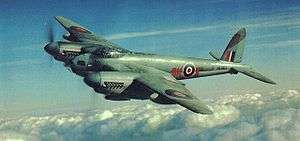No. 571 Squadron RAF
No. 571 Squadron RAF was a Second World War Royal Air Force pathfinder squadron operating the de Havilland Mosquito.
| No. 571 Squadron RAF | |
|---|---|
| Active | 7 Apr 1944 – 20 Sep 1945 |
| Country | |
| Branch | |
| Part of | No. 8 (Pathfinder) Group, RAF Bomber Command |
| Insignia | |
| Squadron Codes | 8K (Apr 1944 – Sep 1945)[1][2] |
History
The squadron was formed on 7 April 1944 at RAF Downham Market, Norfolk to operate the de Havilland Mosquito XVI as part of the No. 8 (Pathfinder) Group. The main squadron role was to carry out independent raids on German industrial targets using 4,000 lb (1,814 kg) "Cookie" bombs. The squadron moved to RAF Oakington on 22 April 1944 and then, after having flown its last operational mission on 26/27 April 1945, to RAF Warboys on 20 July 1945. No. 571 Squadron was disbanded at Warboys on 20 September 1945.[3][4][5]
The squadron carried out 2,681 operational sorties with the Mosquito with a loss of 8 aircraft.[6]

This particular aircraft is, according to "Mosquito" by Sharp & Bowyer, ML963, 8K-K "King" of 571 Squadron, the picture having been taken on 30 September 1944, after the aircraft had completed repairs at Hatfield. ML963 was first issued to 109 Squadron on 9 March 1944, going on to 692 Squadron on the 24th of the same month, and then on to 571 on 19 April 1944. It was damaged in action on 12 May 1944 but returned to the Squadron on 23 October of that year. Barry Blunt's history of 571 Squadron says ML963 completed 84 operations with the Squadron, 31 of them to Berlin (one of the others was a low-level sortie to skip-bomb a 4,000 lb bomb into the Bitburg Tunnel, undertaken on New Year's Day, 1945. The crew were Flt Lt Norman J Griffiths & Flg Off WR Ball). Its final sortie came on 10/11 April 1945, when it was abandoned following an engine fire. The crew of F/O R.D. Oliver and F/S L.M. Young both returned safely to the Squadron later that month
Aircraft operated
| From | To | Aircraft | Variant | Notes |
|---|---|---|---|---|
| April 1944 | September 1945 | de Havilland Mosquito | Mk.XVI | Twin-engined light bomber |
Squadron bases
| From | To | Base | Remark |
|---|---|---|---|
| 7 April 1944 | 24 April 1944 | RAF Downham Market, Norfolk | Det. at RAF Graveley, Huntingdonshire |
| 24 April 1944 | 20 July 1945 | RAF Oakington, Cambridgeshire | |
| 20 July 1945 | 20 September 1945 | RAF Warboys, Huntingdonshire |
Commanding officers
| From | To | Name |
|---|---|---|
| April 1944 | November 1944 | W/Cdr. J.M. Birkin, DSO, DFC, AFC |
| November 1944 | March 1945 | W/Cdr. R.J. Gosnell, DSO, DFC |
| March 1945 | September 1945 | W/Cdr. R.W. Bray, DFC |
gollark: I don't trust them. What if it's a trap?
gollark: Why should we trust the bartender with the macguffin?
gollark: Oh, so RANDOM BARTENDERS can be trusted with ULTIMATE COSMIC POWER which the nice goblins said was bad?
gollark: I attempt to summon apioforms, d6.
gollark: I leave the cavern thing, d6.
References
Notes
- Bowyer and Rawlings 1979, p. 65.
- Flintham and Thomas 2003, p. 61.
- Moyes 1976, pp. 268–269.
- Halley 1988, p. 412.
- Jefford 2001, p. 98.
- Falconer 2003, p. 255.
- Bowyer 1984, p. 119.
Bibliography
- The Illustrated Encyclopedia of Aircraft (Part Work 1982–1985). Orbis Publishing. 1985.
- Blunt, Barry (2003). 571 Mosquito Bomber Squadron. Barry Blunt. ISBN 0-9520532-7-6.
- Bowyer, Chaz (1984). Mosquito Squadron of the Royal Air Force. Shepperton, Surrey, UK: Ian Allan Ltd. ISBN 0-7110-1425-6.
- Bowyer, Michael J.F.; John D.R. Rawlings (1979). Squadron Codes, 1937–56. Cambridge, UK: Patrick Stephens Ltd. ISBN 0-85059-364-6.
- Falconer, Jonathan (2003). Bomber Command Handbook, 1939–1945. Stroud, England: Sutton Publishing. pp. 203–204. ISBN 0-7509-3171-X.
- Flintham, Vic; Andrew Thomas (2003). Combat Codes: A full explanation and listing of British, Commonwealth and Allied air force unit codes since 1938. Shrewsbury, Shropshire, UK: Airlife Publishing Ltd. ISBN 1-84037-281-8.
- Halley, James J. (1988). The Squadrons of the Royal Air Force & Commonwealth, 1918–1988. Tonbridge, Kent, UK: Air-Britain (Historians) Ltd. ISBN 0-85130-164-9.
- Jefford, Wing Commander C.G. (2001). RAF Squadrons, a Comprehensive record of the Movement and Equipment of all RAF Squadrons and their Antecedents since 1912. Shrewsbury, Shropshire, UK: Airlife Publishing Ltd. ISBN 1-85310-053-6.
- Moyes, Philip J.R. (1976). Bomber Squadrons of the RAF and their Aircraft. London: Macdonald and Jane's (Publishers) Ltd. ISBN 0-354-01027-1.
External links
| Wikimedia Commons has media related to No. 571 Squadron RAF. |
This article is issued from Wikipedia. The text is licensed under Creative Commons - Attribution - Sharealike. Additional terms may apply for the media files.
